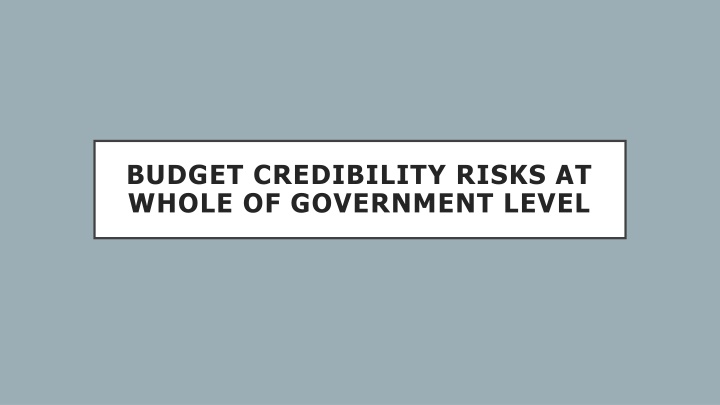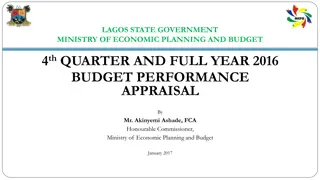Managing Budget Credibility Risks at Whole of Government Level
Understanding and addressing budget credibility risks at the whole of government level is crucial for effective financial management. Common indicators of risks include unrealistic revenue projections and financial indiscipline. Linkages between government-wide credibility and program-level performance highlight the importance of robust public financial management systems. Supreme Audit Institutions (SAIs) play a key role in identifying weaknesses and making recommendations for improvement in budget processes.
Download Presentation

Please find below an Image/Link to download the presentation.
The content on the website is provided AS IS for your information and personal use only. It may not be sold, licensed, or shared on other websites without obtaining consent from the author.If you encounter any issues during the download, it is possible that the publisher has removed the file from their server.
You are allowed to download the files provided on this website for personal or commercial use, subject to the condition that they are used lawfully. All files are the property of their respective owners.
The content on the website is provided AS IS for your information and personal use only. It may not be sold, licensed, or shared on other websites without obtaining consent from the author.
E N D
Presentation Transcript
BUDGET CREDIBILITY RISKS AT WHOLE OF GOVERNMENT LEVEL
Understanding credibility risks at the whole of government Budget credibility at the whole of Government level is directly linked to the strength/robustness of the PFM systems Understanding budget credibility at the whole-of-government level requires looking at risks to budget functions and processes at a consolidated level (involving all the players along the PFM system) The risks to budget credibility at the whole of Government level can occur at any stage of the budget cycle; Budget formulation stage, Budget approval stage, Budget execution stage, Budget reporting and accounting systems External oversight and evaluation
What are some of the common indicators of budget credibility risks at the whole of government Budget formulation Unrealistic revenue and expenditure projections/forecasts. Misalignment of budgets to long-term planning frameworks and the SDGs. Budget formulation Delays in budget approval by the legislature. Budget execution stage Implementation of unapproved and off-budget activities Financial indiscipline within the executive and legislature Budget reporting and accounting systems Ineffective reporting and accounting systems External oversight and evaluation: Capacity of parliament and SAIs to provide evaluation and oversight of budget execution
Linkages between credibility at the whole of government and programme level Budget credibility at Government wide level directly determines performance at programme level. Once there are systemic weaknesses within the PFM system that result in credibility risks at the whole of government, then government promises in the budgets cannot be achieved. For instance once the revenue forecast is far below what is collected due to inaccurate forecasts, then the promised investments in service delivery by Government will be affected since there will be no funds to invest. Once the legislative/oversight function is weak, the executive will take advantage and divert resources to other programmes without seeking authorization. This will affect performance at programme level.
Contribution of the SAIs to address budget credibility risks The role of SAIs in addressing credibility risks cannot be overemphasized. SAIs are in a central position to make recommendations through audits to improve the budget processes at all levels. Through the regular/routine audits and follow-ups SAIs should be able to evaluate budgeting systems (using the different types of audits) and identify areas of weakness, and make appropriate recommendations to those charged with Governance for improving the system. As SAI, Uganda undertakes budget performance reviews every year focusing on particular stages of the budget processes. As a result of these audits, a separate thematic report about the performance of the budgets is sent to parliament and shared with the Ministry of Finance. In addition, performance audits have been done the budget processes and recommendations issued. In 2023, the Office undertook a detailed assessment of the PFM system and the report is before parliament for discussion. These audits have highlighted several challenges that have resulted in policy changes, automation of government processes, and amendments to the legislation particularly the Public Finance Management Act (PFMA) and regulations (PFMR)
Value addition from the work of SAIs- a case of SAI Uganda Over the years, recommendations have been made to improve credibility of the budget for example Recommendations against off-budget expenditure have seen the executive pass a policy which holds any officer who spends funds outside the budget culpable . Recommendations to address inefficiencies within the procurement processes which lead to delays in implementing planned activities saw the procurement law revised in May 2023. The PFMA is currently being amended and one of the reasons is to curb un-justified supplementary requests by the executive which distort the implementation of the budget and cause diversions. Recommendations to enhance performance reporting have seen the executive produce quarterly budget performance information which is accessed by all citizens. This has improved transparency and accountability for budget promises. Every year the National Planning Authority rates the extent of compliance of the annual budget to the approved National Development Plan to ensure the budget is delivering NDP aspirations.
Conclusion The handbook provides rich insights into the risks that affect credibility of Government budgets and what SAIs can do through their audit work to improve systems and address these challenges. I therefore encourage all SAIs to use the handbook for impactful audits in the area of budget performance. THANK YOU























